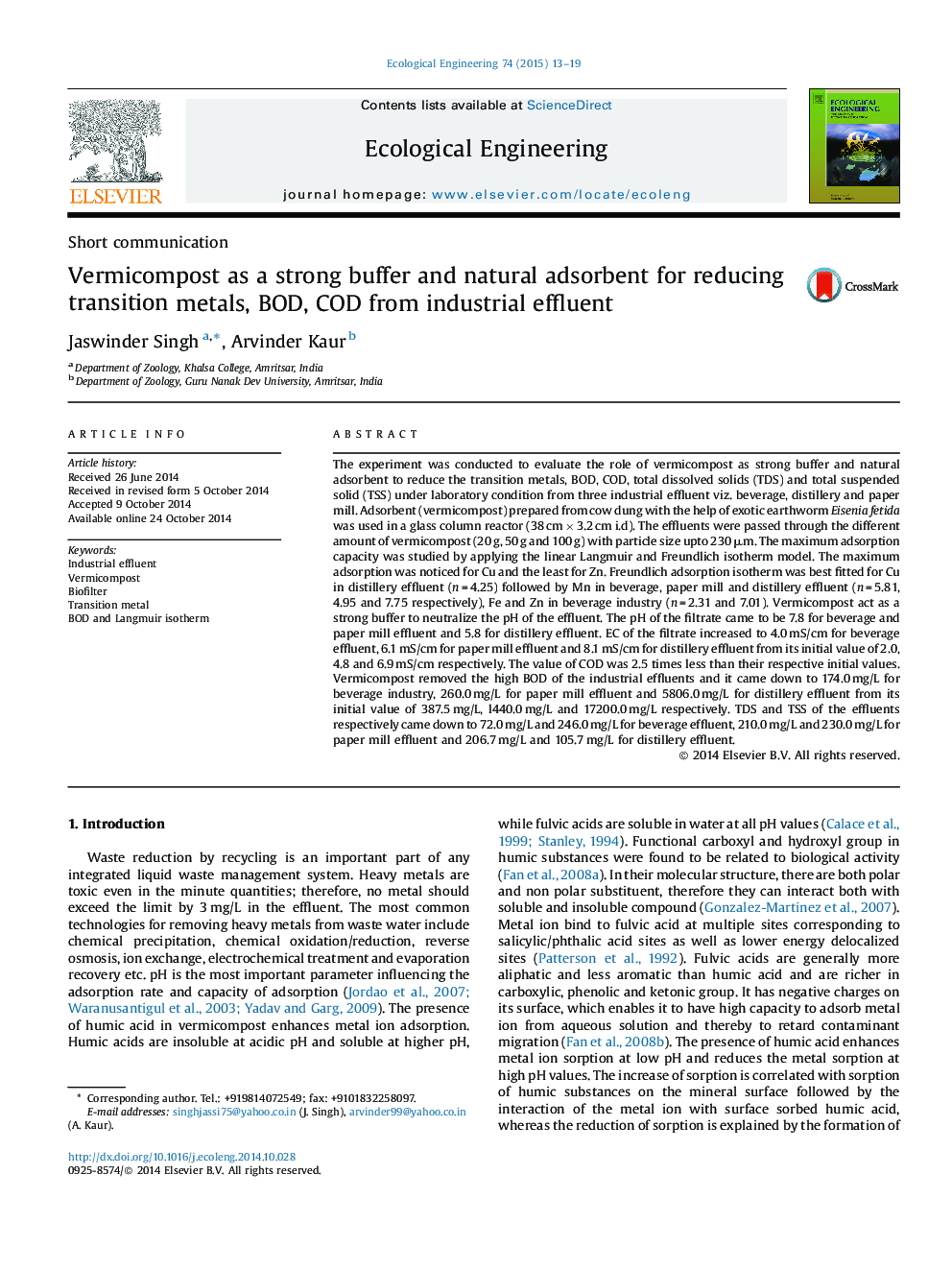| کد مقاله | کد نشریه | سال انتشار | مقاله انگلیسی | نسخه تمام متن |
|---|---|---|---|---|
| 4389288 | 1618025 | 2015 | 7 صفحه PDF | دانلود رایگان |
عنوان انگلیسی مقاله ISI
Vermicompost as a strong buffer and natural adsorbent for reducing transition metals, BOD, COD from industrial effluent
دانلود مقاله + سفارش ترجمه
دانلود مقاله ISI انگلیسی
رایگان برای ایرانیان
کلمات کلیدی
موضوعات مرتبط
علوم زیستی و بیوفناوری
علوم کشاورزی و بیولوژیک
بوم شناسی، تکامل، رفتار و سامانه شناسی
پیش نمایش صفحه اول مقاله

چکیده انگلیسی
The experiment was conducted to evaluate the role of vermicompost as strong buffer and natural adsorbent to reduce the transition metals, BOD, COD, total dissolved solids (TDS) and total suspended solid (TSS) under laboratory condition from three industrial effluent viz. beverage, distillery and paper mill. Adsorbent (vermicompost) prepared from cow dung with the help of exotic earthworm Eisenia fetida was used in a glass column reactor (38 cm Ã 3.2 cm i.d). The effluents were passed through the different amount of vermicompost (20 g, 50 g and 100 g) with particle size upto 230 μm. The maximum adsorption capacity was studied by applying the linear Langmuir and Freundlich isotherm model. The maximum adsorption was noticed for Cu and the least for Zn. Freundlich adsorption isotherm was best fitted for Cu in distillery effluent (n = 4.25) followed by Mn in beverage, paper mill and distillery effluent (n = 5.81, 4.95 and 7.75 respectively), Fe and Zn in beverage industry (n = 2.31 and 7.01). Vermicompost act as a strong buffer to neutralize the pH of the effluent. The pH of the filtrate came to be 7.8 for beverage and paper mill effluent and 5.8 for distillery effluent. EC of the filtrate increased to 4.0 mS/cm for beverage effluent, 6.1 mS/cm for paper mill effluent and 8.1 mS/cm for distillery effluent from its initial value of 2.0, 4.8 and 6.9 mS/cm respectively. The value of COD was 2.5 times less than their respective initial values. Vermicompost removed the high BOD of the industrial effluents and it came down to 174.0 mg/L for beverage industry, 260.0 mg/L for paper mill effluent and 5806.0 mg/L for distillery effluent from its initial value of 387.5 mg/L, l440.0 mg/L and 17200.0 mg/L respectively. TDS and TSS of the effluents respectively came down to 72.0 mg/L and 246.0 mg/L for beverage effluent, 210.0 mg/L and 230.0 mg/L for paper mill effluent and 206.7 mg/L and 105.7 mg/L for distillery effluent.
ناشر
Database: Elsevier - ScienceDirect (ساینس دایرکت)
Journal: Ecological Engineering - Volume 74, January 2015, Pages 13-19
Journal: Ecological Engineering - Volume 74, January 2015, Pages 13-19
نویسندگان
Jaswinder Singh, Arvinder Kaur,